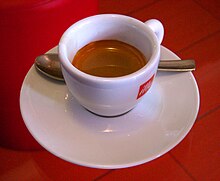Short black

Classic espresso
|
|
| Type | Hot |
|---|---|
| Country of origin | Italy |
| Color | Black |
| Nutritional value per 100 g (3.5 oz) | |
|---|---|
| Energy | 8.4 kJ (2.0 kcal) |
|
0.
|
|
|
0.2
|
|
|
0.1
|
|
| Vitamins | |
| Riboflavin (B2) |
(17%)
0.2 mg |
| Niacin (B3) |
(35%)
5.2 mg |
| Minerals | |
| Magnesium |
(23%)
80 mg |
| Other constituents | |
| Water | 97.8 g |
| Theobromine | 0 mg |
| Caffeine | 212 mg |
|
|
|
|
|
| Percentages are roughly approximated using US recommendations for adults. | |
Espresso (/ɛˈsprɛsoʊ/, Italian: [esˈprɛsso]) is coffee brewed by forcing a small amount of nearly boiling water under pressure through finely ground coffee beans. Espresso is generally thicker than coffee brewed by other methods, has a higher concentration of suspended and dissolved solids, and has crema on top (a foam with a creamy consistency). As a result of the pressurized brewing process, the flavors and chemicals in a typical cup of espresso are very concentrated. Espresso is also the base for other drinks such as a caffè latte, cappuccino, caffè macchiato, caffè mocha, flat white, or caffè Americano.
Espresso has more caffeine per unit volume than most coffee beverages, but because the usual serving size is much smaller, the total caffeine content is less than a mug of standard brewed coffee, contrary to a common belief. Although the actual caffeine content of any coffee drink varies by size, bean origin, roast method and other factors, the caffeine content of "typical" servings of espresso vs. drip brew are 120 to 170 mg vs. 150 to 200 mg.
Espresso is made by forcing very hot water under high pressure through finely ground, compacted coffee. Tamping down the coffee promotes the water's even penetration of the grounds. This process produces an almost syrupy beverage by extracting both solid and dissolved components. The crema is produced by emulsifying the oils in the ground coffee into a colloid, which does not occur in other brewing methods. There is no universal standard defining the process of extracting espresso, but there are several published definitions which attempt to place constraints on the amount and type of ground coffee used, the temperature and pressure of the water, and the rate of extraction. Generally, one uses an espresso machine to make espresso. The act of producing a shot of espresso is often termed "pulling" a shot, originating from lever espresso machines, which require pulling down a handle attached to a spring-loaded piston, forcing hot water through the coffee at high pressure. Today, however, it is more common for the pressure to be generated by an electric pump.
...
Wikipedia
